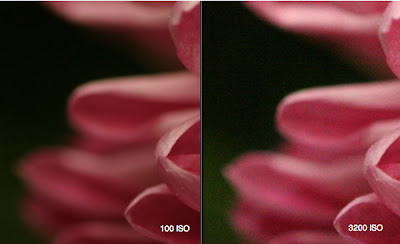noise :
grainy look digital photos sometimes get, usually noticeable as multi colored speckles most visible in dark or shadow areas of image
- destroys detail in your image
- limit how much you can enlarge before the graininess becomes obtrusive
changing the ISO setting on your camera changes the sensitivity to light of the image sensor inside of it
- lower number that you select the less sensitive the sensor is to light
- higher the number the more sensitive it becomes
– when using a tripod you might be able to use a slower shutter speed which would allow you to lower your ISO
– if your subject is perfectly still (like when shooting a still life) and where you’re using a tripod you’ll be able to slow your shutter speed and lower ISO
– If you don’t need a large depth of field you might be able to increase your aperture which allows more light into the camera and will allow you to lower ISO
– using a flash or even switching on a light can help to get more light into your camera – allowing you to decrease your ISO setting
– sometimes a photo can actually look better with grain. Some photographers love the mood and atmosphere that a little noise can add and will bump up their ISO in the hope of getting it
– the reason that noise is not able to be seen on your camera’s LCD is that it is very small. As a result the pixels in the picture are small also and the grain is unable to be seen. It is only when you enlarge the picture on a larger screen or in printing that it becomes noticeable. If you’re only ever going to use the shot in a small size you can probably get away with a higher ISO
source : digital photography school
source : digital photography school





No comments:
Post a Comment